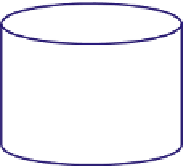Biomedical Engineering Reference
In-Depth Information
16.24.
Organism A grows on substrate S and produces product P, which is the only substrate
that organism B can utilize. The batch kinetics gives rise to
d
X
A
d
t
¼
m
Amax
S
K
S
þS
X
A
d
X
B
d
t
¼
m
Bmax
P
K
P
þP
X
B
d
P
d
t
¼
YF
P=A
m
Amax
S
YF
B=P
m
Bmax
P
1
K
S
þS
X
A
K
P
þP
X
B
YF
P
=
A
d
S
d
t
¼
YF
A=S
m
Amax
S
1
YF
P=S
m
Amax
S
K
S
þS
X
A
K
S
þS
X
A
Assume the following parameter values:
m
Amax
¼
0.18 h
1
;
m
Bmax
¼
0.29 h
1
, K
S
¼
0.42 g/L, K
P
¼
0.30 g/L, YF
A/S
¼
0.30 g/g,
YF
B/S
¼
0.5 g/g, YF
P/S
¼
1.0 g/g, YF
P/A
¼
4.0 g/g, S
0
¼
10 g/L.
Determine the behavior of these two organisms in a chemostat. Plot S, P, X
A
, and X
B
versus dilution rate. Discuss what happens to organism B as the dilution rate
approaches the washout dilution rate for organism A.
16.25.
An activated-sludge waste treatment system (
Fig. P16.25
) is required to reduce the
amount of BOD
5
from 1 to 0.02 g/L at the exit. The sedimentation unit concentrates
biomass by a factor of 3. Kinetic parameters are
m
max
¼
0.2 h
1
; K
S
¼
0.08 g/L, YF
X/S
¼
0.50 g-MLVSS/g-BOD
5
, k
d
¼
0.01 h
1
. The flow of wastewater is 10,000 l/h and the
size of the treatment basin is 50,000 L.
(a)
What is the value of the net specific growth rate of cells,
m
net
?
(b)
What value of the recycle ratio must be used?
Q
,
S
0
(1 -
y
s
)
Q
X
,
S
Waste water
Effluent
S
e
,
X
e
(1 +
R
)
Q
V, X, S
Air
RQ
S
R
,
Sedimentation
unit
X
R
(
R + y
s
)
Q
Activated sludge reactor
S
R
=
S
e
X
R
=
c
R
X
y
s
Q, S
R
,
X
R
Excess sludge
FIGURE P16.25
Schematic of an activated sludge waste treatment system.


































































Search WWH ::

Custom Search